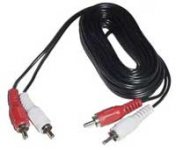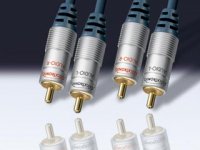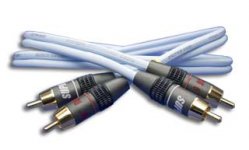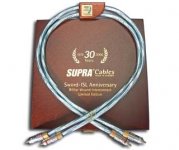none of this has to do with preference.
If you like *&^%## then that is fine. go for it.
the argument is audible difference. (due to factors unknown to science/engineering)
If you like *&^%## then that is fine. go for it.
the argument is audible difference. (due to factors unknown to science/engineering)
I have done a similar test with the help of my son, I've left the room each time for a minute so he could change or not change the direction of an interconnect randomly. Note that I had to change the cable direction at least ten times sighted before I've heard a small difference. He sat with his back in my direction and wasn't allowed to talk to me at any time during the test. I listened and tell him which way round the cable were before leaving the room for the next test.
The difficult part for me was when the cable stayed the same direction for four consecutive tests, sort of losing your reference.
I quited after nine tests because I was exhausted and lost interest.
The result, I called the direction the wrong way round, eight out of the nine times. 😀
Now tell me what to make of that.
To me the test shown the direction was not important with that interconnect, I will try again, sometime when I'm bored, with a different cable.
André
The difficult part for me was when the cable stayed the same direction for four consecutive tests, sort of losing your reference.
I quited after nine tests because I was exhausted and lost interest.
The result, I called the direction the wrong way round, eight out of the nine times. 😀
Now tell me what to make of that.
To me the test shown the direction was not important with that interconnect, I will try again, sometime when I'm bored, with a different cable.
André
The result, I called the direction the wrong way round, eight out of the nine times.
Did you guess wrong 8 times out of 9 ?
In other words, did you guess the direction incorrectly on 8 out of the 9 tests ?
If so, you need to confirm that you weren't guessing correctly 8 out of 9 times by consistantly going for the wrong cable direction, which would imply that you heard a difference.
Or, did you guess the direction ( wrong meaning that the interconnect was in the opposite direction of it's so called directionality ) of the cable 8 out of 9 times ?
Your conclusion was that the direction was not important, so I presume it wasn't the latter.
And why couldn't you have done 10 tests so that I could use percentages without having to use the calculator, and force me to say 8 out of 9 times, 5 times ?

mwaters10, If I had to guess, I wouldn't have done the test at all.😀
When I said the cable was the 'right' way round, it was actually the 'wrong' way round.
The only reason I say that the direction was not important is because the difference was so small, even with sighted listening.
André
When I said the cable was the 'right' way round, it was actually the 'wrong' way round.
The only reason I say that the direction was not important is because the difference was so small, even with sighted listening.
André
This is bizarre isn't it ?
Did you find yourself thinking that maybe you marginally preferred the cables the wrong way round ?
To me this is symbolic in many ways of the BS that surrounds cable choice.
One bloke on one of the diyAudio threads believes that film capacitors sound better in a particular orientation. It would not surprise me if some moronic audiophile has changed the direction of the coil in his crossover.
I always remind myself about the aluminium wire used in my loudspeaker voice coil if I ever start to get any urges to experiment with cables.
It's ridiculous how audio interconnect manufacturers have gotten away with all their BS claims for so long.
Did you find yourself thinking that maybe you marginally preferred the cables the wrong way round ?
To me this is symbolic in many ways of the BS that surrounds cable choice.
One bloke on one of the diyAudio threads believes that film capacitors sound better in a particular orientation. It would not surprise me if some moronic audiophile has changed the direction of the coil in his crossover.
I always remind myself about the aluminium wire used in my loudspeaker voice coil if I ever start to get any urges to experiment with cables.
It's ridiculous how audio interconnect manufacturers have gotten away with all their BS claims for so long.
audio-kraut said:
<snip>
There was for instance a preliminary test that indicated non audibility of differences, .......
No, the author mentioned that preliminary tests were conducted in the test design process, but he didn´t tell any results of these preliminary tests, just that the given answering scheme was changed due to panel reactions during the preliminary tests.
The authors initially planned to use a 2-alternative forced choice test (only using the answers "1 better than 2" and "2 better than 1"), based on recommendations of his professor, but as he was using a panel test, it became obvious that listeners not hearing a difference would disturb others, because the answer "no difference" wasn´t included at first.
So he switched over to a 3-alternative forced choice test (with 3 answers "1 better than 2", " no difference", " 2 better than 1")
The final test was conducted during the High-End-Fair in Frankfurt in 2001 with normal visitors of the show.
Loudspeaker was an active 3-way-Monitor from Sehring, according to the author specially selected and measured to tighter channel matching.
Preamplifier was PRE G2 from Audionet, all cables were from HMS, which supplied the two DUTs, (C01 and Gran Finale Interconnect -GFI-), both supplied in a special outer sleeve version, to avoid that the experimentator or listeners do recognize a difference by sight.
Two cd-players were used, both the model ART from Audionet, both measured and tested before to ensure that no differences were generated by the cd-players.
To further evaluate the possible risk of differences the test was done in two groups, "heat A" and "heat B" in which the cd-players were exchanged.
The room size was roughly 22 sqm, with a roof truss height of approx. 5m (This information wasn´t supplied by the author, but came from my memory as i did some exhibition in similar rooms myself and remember the quite difficult room acoustic properties; especially the height creates awful flutter echoes if left untreated)
To overcome the flutter echoes the roof truss was filled up with air balloons which effectively removes this problem; the room itself was additionally treated with absorbers.
A maximum of 10 listeners could participate at the same time.
In preliminary tests and during interviews at several road shows, the authors choosed 6 different music samples, which were recorded to CD-Rs.
In each trial, the music sample was played for 1 minute, then were the first 10 seconds repeated as a reminder, then switched over to the other cable and played for 1 minute and then the first 10 seconds were repeated as a reminder.
After that procedure the answers were written down by the listeners and the next music samples was played.
In each trial the relation between the DUT and "1" or "2" was choosen randomly.
The third music sample trial served as a negative control, as the switch over was only pretended, in fact the panel was listening to the same cable twice.
In heat B the cd-players in relation to the DUTs were exchanged and additionally the CD-R playing with the higher priced interconnect got an additional treatment.
Overall 112 listeners participated, 70 in heat A and 42 in heat B.
Results were in heat A (C01 connected to CD2):
A1; C01 was no.2
1bt2: 15=21%
2bt1: 39=56%
nodi: 16=23%
A2; C01 was no.1
1bt2: 31=44%
2bt1: 19=27%
nodi: 20=29%
A3; control trial
1bt2: 30=43%
2bt1: 27=38%
nodi: 13=19%
A4; GFI was no.2
1bt2: 19=27%
2bt1: 33=47%
nodi: 18=26%
A5; GFI was no.1
1bt2: 34=49%
2bt1: 22=31%
nodi: 14=20%
A6; C01 was no.2
1bt2: 11=16%
2bt1: 38=54%
nodi: 21=30%
Heat B (C01 connected to CD1):
B1; GFI was no.2
1bt2: 12=29%
2bt1: 21=50%
nodi: 9=21%
B2; C01 was no. 2
1bt2: 8=19%
2bt1: 20=48%
nodi: 14=33%
B3; control trial
1bt2: 18=43%
2bt1: 17=40%
nodi: 7=17%
B4; C01 was no.2
1bt2: 7=17%
2bt1: 27=64%
nodi: 8=19%
B5; C01 was no.1
1bt2: 27=64%
2bt1: 6=15%
nodi: 9=21%
B6; GFI was no.2
1bt2: 13=31%
2bt1: 20=48%
nodi: 9=21%
music samples were
1: allison kraus "it doesn´t matter"
2: radka toneff "the moon is a harsh mistress"
3: w.a.mozart "Der Vogelfänger" aus "Die Zauberflöte"
4: georg friedrich haendel- satz 1 aus "Feuerwerksmusik"
5: Sarah K. "oh well"
6: acoustic alchemy "reference point"
No, the author mentioned that preliminary tests were conducted in the test design process, but he didn´t tell any results of these preliminary tests, just that the given answering scheme was changed due to panel reactions during the preliminary tests.
I remember now - this "baseline test" was an announced "switch" without a switch actually taking place. Some in this test also reported hearing a difference.
Now tell me what to make of that.
That you didn't really control the test properly, you controlled the test the way you THINK is acceptable.
Well, I just thought it was due time to actually see what kind of cables it is we are talking about 😀
mwaters10 said:This is bizarre isn't it ?
Did you find yourself thinking that maybe you marginally preferred the cables the wrong way round ?
To me this is symbolic in many ways of the BS that surrounds cable choice.
One bloke on one of the diyAudio threads believes that film capacitors sound better in a particular orientation. It would not surprise me if some moronic audiophile has changed the direction of the coil in his crossover.
I always remind myself about the aluminium wire used in my loudspeaker voice coil if I ever start to get any urges to experiment with cables.
It's ridiculous how audio interconnect manufacturers have gotten away with all their BS claims for so long.
First, I said I've heard a small difference, after all it is the same cable (coaxial) with no reason to make any difference in sound.
It is quite possible that the orientation of a coil or capacitor can have an influence on the sound, I connect the outer foil or wire to 0V or lowest impedance.
I choose to think of the voicecoil as part of the transducer (just as a filament is part of a light bulb), trying to deliver the signal as purely as possible to it.
I'm not familiar with all the BS claims of interconnect manufacturers, surely there must be just as in any other market, I prefer to listen to them and decide for myself whether it is a worthwhile improvement or not.
André
One bloke on one of the diyAudio threads believes that film capacitors sound better in a particular orientation.
That's actually possible.
Resistor orientation, which one guy insisted on, using the stripes to guide it, isn't, as anyone who has seen resistors being assembled is aware.
SY said:That you didn't really control the test properly, you controlled the test the way you THINK is acceptable.




Try again SY, perhaps something better.
As I've said, to me the difference are so small that I would not bother, fact is the blind test show a difference and we are not even talking about different cables with all their possible L,C,R, interference or whatever differences "affecting" the system.
FYI - In microwave circuits the self resonance of a ceramic chip cap depends on it's mounting orientation. Mount it the wrong way and it doesn't work anymore.
Andre: IOW, just like that other fellow, you don't want to bother instituting controls and your request was made just to waste my time.
Ok, electrolytics I understand that, but film capacitors, that's starting to get a little ridiculous .. and now please ...
This is a joke right ?
You can't even guess right the orientation of your interconnects.
the orientation of a coil
This is a joke right ?
You can't even guess right the orientation of your interconnects.
Clearly, you've never made nor unwrapped a film cap. Note that one layer surrounds the outside. Now if one end is at a low impedance and the other end is at high impedance (typical use for a coupling, bypass, or filter cap), the influence of fields and strays will be different, no? A coil which is not geometrically symmetric could also possibly show an orientation effect.
- Status
- Not open for further replies.
- Home
- Design & Build
- Parts
- I don't believe cables make a difference, any input?



